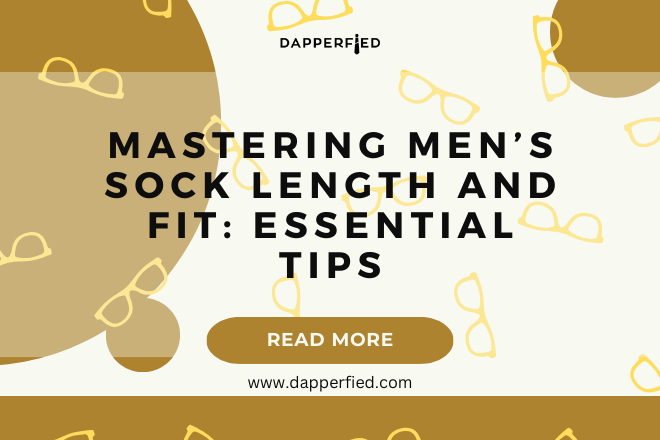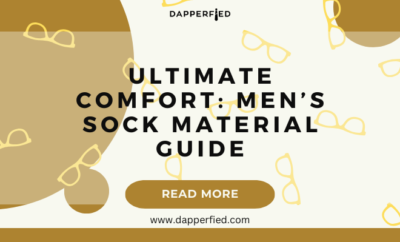
Men's Style
Men’s Ultimate Sock Selection Guide
Socks are available in various types, each designed for specific purposes and activities. Athletic socks provide extra cushioning and support during physical activities like running, hiking, or sports. They often incorporate moisture-wicking materials to keep feet dry and comfortable.
Dress socks, typically made from finer materials such as cotton, wool, or silk, are intended for formal or professional occasions and come in various colors and patterns to complement different outfits. Compression socks are designed to improve circulation and reduce swelling in the legs and feet, making them suitable for long flights or individuals who spend extended periods on their feet. Specialty socks include toe socks, which have individual compartments for each toe to prevent blisters and promote better toe alignment.
No-show or low-cut socks have gained popularity in recent years. These socks are designed to be worn with low-cut or no-show shoes such as loafers, boat shoes, or sneakers, providing comfort and protection without being visible above the shoe. They often feature silicone grips on the heel to prevent slipping.
Understanding the different types of socks available enables individuals to select the most appropriate socks for their specific needs and activities.
Key Takeaways
- There are different types of socks including dress socks, athletic socks, and casual socks, each designed for specific activities and occasions.
- When choosing socks, consider factors such as material, fit, cushioning, and moisture-wicking properties to ensure comfort and performance.
- Sock materials like cotton, wool, and synthetic fibers offer various benefits such as breathability, insulation, and durability.
- Sock lengths vary from no-show and ankle socks to crew and knee-high socks, with each length suitable for different types of footwear and outfits.
- Sock styles like patterned, colored, and novelty socks can add a fun and fashionable touch to any outfit, while classic solid colors are versatile for formal occasions.
Factors to Consider When Choosing Socks
Material Matters
The material of the socks is a crucial factor to consider. Different materials offer unique benefits, so it’s vital to think about breathability, moisture-wicking properties, and warmth when making a selection. For instance, wool socks are renowned for their warmth and moisture-wicking properties, making them perfect for outdoor activities in cold weather. In contrast, cotton socks are lightweight and breathable, making them an excellent choice for everyday wear.
Finding the Perfect Fit
The fit of the socks is another critical factor to consider. Socks that are too tight can restrict circulation and cause discomfort, while those that are too loose can slip down and cause irritation. It’s essential to choose socks that fit snugly without being constricting. Additionally, the length of the socks should be considered based on the type of shoes they will be worn with. For example, crew socks are ideal for wearing with boots or high-top sneakers, while no-show socks are better suited for low-cut shoes.
Considering the Intended Use
The intended activity or purpose of the socks should also be taken into account when making a selection. For athletic activities, socks with extra cushioning and support may be necessary, while for formal occasions, dress socks in a suitable color and pattern may be more appropriate. By considering these factors, individuals can choose socks that provide the right level of comfort and functionality for their specific needs.
Sock Materials and Their Benefits
Socks are made from a variety of materials, each with its own unique benefits and properties. One of the most popular materials for socks is cotton. Cotton socks are lightweight, breathable, and soft, making them a comfortable choice for everyday wear.
They are also absorbent, which helps to keep feet dry and reduce the risk of blisters. Another common material for socks is wool. Wool socks are known for their warmth and moisture-wicking properties, making them an ideal choice for outdoor activities in cold weather.
They are also naturally odor-resistant and provide cushioning for added comfort. Synthetic materials such as polyester and nylon are often used in athletic socks due to their durability and moisture-wicking properties. These materials help to keep feet dry and reduce friction, making them ideal for high-intensity activities.
Additionally, compression socks are often made from a blend of spandex and nylon to provide a snug fit and improve circulation in the legs and feet. Silk is another luxurious material used in dress socks. Silk socks are lightweight, smooth, and offer a sleek appearance, making them a popular choice for formal occasions.
Bamboo is a newer material that has gained popularity in sock manufacturing due to its eco-friendly and sustainable properties. Bamboo socks are soft, breathable, and naturally antibacterial, making them a great choice for individuals with sensitive skin or allergies. Understanding the benefits of different sock materials can help individuals choose the right socks for their specific needs and preferences.
Sock Lengths and When to Wear Them
| Sock Length | When to Wear |
|---|---|
| Ankle | With sneakers or low-cut shoes |
| Crew | With casual or athletic shoes |
| Knee-high | With boots or under long pants |
Socks come in a variety of lengths, each designed for specific types of shoes and activities. Ankle socks, also known as no-show or low-cut socks, are designed to be worn with low-cut or no-show shoes such as loafers, boat shoes, or sneakers. They provide the comfort and protection of a sock without being visible above the shoe.

Crew socks are a popular choice for everyday wear and are designed to cover the ankle and extend up to the mid-calf. They are versatile and can be worn with a wide range of shoe styles, including boots and sneakers. Knee-high socks are longer in length and extend up to the knee or just below it.
They are often worn for athletic activities such as soccer or hockey to provide extra warmth and protection for the lower legs. Dress socks typically come in a variety of lengths, including crew length and over-the-calf length. The length of dress socks should be chosen based on the height of the dress shoes being worn.
Over-the-calf dress socks are ideal for taller boots or for individuals who prefer extra coverage. Understanding the different sock lengths and when to wear them can help individuals choose the right socks for their specific shoes and activities.
Sock Styles and Fashion Tips
Socks have become an important fashion accessory in recent years, with a wide range of styles and patterns available to complement different outfits. When it comes to choosing sock styles, there are several factors to consider to ensure that they complement the overall look. For formal occasions, it’s important to choose dress socks in a color that complements the outfit.
Neutral colors such as black, navy, gray, or brown are versatile options that can be paired with a variety of dress shoes and suits. For more casual looks, individuals can have fun with patterns and colors to add a pop of personality to their outfit. Striped or polka dot socks can add a playful touch to a casual ensemble, while solid-colored socks in bold hues can make a statement when paired with neutral clothing.
It’s important to consider the overall color scheme of the outfit when choosing patterned or colorful socks to ensure that they complement rather than clash with the rest of the clothing. Another popular trend in sock fashion is novelty or themed socks. These socks feature fun designs such as animals, food items, or pop culture references and can be a great conversation starter or a way to showcase personal interests.
When wearing novelty socks, it’s important to consider the occasion and ensure that they are appropriate for the setting. By considering these fashion tips and exploring different sock styles, individuals can elevate their outfit with this often-overlooked accessory.
Sock Care and Maintenance
Washing Socks According to Material
One important aspect of sock care is washing them according to their specific material requirements. For example, wool socks should be hand-washed or washed on a gentle cycle with cold water to prevent shrinking or damage to the fibers. Cotton socks can typically be machine-washed on a regular cycle with warm water.
Avoiding Damage and Maintaining Shape
It’s important to avoid using bleach or fabric softeners when washing socks, as these can cause damage to the fibers and affect their performance. Additionally, it’s recommended to air-dry socks whenever possible to prevent shrinkage and maintain their shape. If using a dryer, it’s best to use a low heat setting to avoid damaging the elastic in the sock.

Proper Storage and Organization
Storing socks properly is also important for maintaining their shape and preventing stretching or damage. Socks should be folded together rather than balled up to prevent stretching out the elastic. It’s also helpful to organize socks by type or color to make it easier to find matching pairs. By following these care and maintenance tips, individuals can ensure that their socks remain in good condition and continue to provide comfort and support.
Top Brands and Where to Find Them
There are many top brands that offer high-quality socks in a variety of styles and materials. Some popular brands include Bombas, which is known for its comfortable athletic and everyday socks with a mission to donate a pair for every pair purchased; Stance, which offers stylish and innovative designs in both athletic and casual sock categories; Smartwool, which specializes in merino wool socks for outdoor activities; Darn Tough, which is known for its durable and long-lasting performance socks; Happy Socks, which offers colorful and playful designs in both dress and casual sock categories; and Falke, which is renowned for its luxury dress socks made from high-quality materials. These brands can be found at specialty sock stores as well as department stores and online retailers such as Amazon, Nordstrom, REI, and Zappos.
Many brands also have their own websites where customers can shop directly for their products. By exploring these top brands and where to find them, individuals can discover high-quality socks that meet their specific needs and preferences.
If you’re looking for more tips on men’s fashion, be sure to check out Dapperfied’s article on trendy men’s clothing tips. This article offers great advice on how to stay stylish and on-trend.
FAQs
What are the different types of socks for men?
There are various types of socks for men, including dress socks, athletic socks, casual socks, and compression socks. Each type serves a different purpose and is designed for specific activities or occasions.
What materials are commonly used in men’s socks?
Common materials used in men’s socks include cotton, wool, bamboo, polyester, and nylon. Each material offers different benefits such as breathability, moisture-wicking, and durability.
How do I choose the right size of socks?
To choose the right size of socks, it’s important to consider your shoe size and the sizing chart provided by the sock manufacturer. Socks that are too small can be uncomfortable, while socks that are too large may bunch up and cause blisters.
What are the key factors to consider when selecting socks for men?
Key factors to consider when selecting socks for men include the intended use (e.g., dress, athletic, casual), material, cushioning, breathability, moisture-wicking properties, and size. It’s also important to consider personal preferences and any specific foot conditions or requirements.
How do I care for my socks to ensure longevity?
To ensure the longevity of your socks, it’s important to follow the care instructions provided by the manufacturer. This may include washing them in cold water, avoiding bleach and fabric softeners, and air-drying them instead of using a dryer. Proper care can help maintain the shape, color, and elasticity of the socks.

















